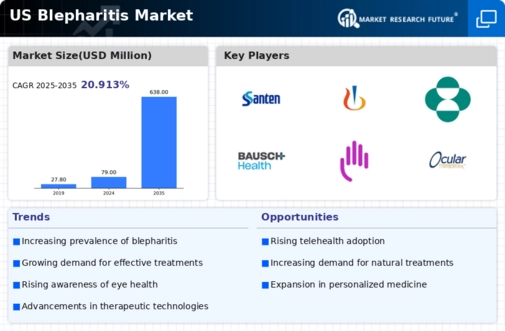Rising Geriatric Population
The aging population in the US is a crucial factor driving the blepharitis market. As individuals age, they become more susceptible to various eye conditions, including blepharitis. The geriatric demographic is projected to grow significantly, with estimates suggesting that by 2030, nearly 20% of the US population will be over 65 years old. This demographic shift is likely to result in an increased prevalence of blepharitis, as older adults often experience changes in eyelid structure and function. Consequently, healthcare providers and manufacturers are expected to focus on developing targeted treatments and interventions for this age group, thereby expanding the market to meet the needs of an aging population.
Increasing Prevalence of Blepharitis
The rising incidence of blepharitis in the US is a notable driver for the blepharitis market. Studies indicate that approximately 30% of the population experiences some form of eyelid inflammation, which can lead to blepharitis. This growing prevalence is likely to increase demand for effective treatment options, thereby expanding the market. As more individuals seek medical attention for their symptoms, healthcare providers are prompted to offer a wider range of therapeutic solutions. The increasing number of patients diagnosed with blepharitis is expected to drive market growth, as pharmaceutical companies and medical device manufacturers respond to this demand with innovative products and services tailored to manage this condition.
Advancements in Diagnostic Techniques
Recent advancements in diagnostic techniques are significantly influencing the blepharitis market. Enhanced diagnostic tools, such as digital imaging and tear film analysis, allow for more accurate identification of blepharitis and its underlying causes. This precision in diagnosis not only improves patient outcomes but also encourages more individuals to seek treatment. As healthcare professionals become more adept at diagnosing blepharitis, the market is likely to see an increase in the number of patients receiving appropriate care. Furthermore, the integration of these advanced diagnostic methods into routine eye examinations may lead to earlier detection and intervention, ultimately contributing to market expansion.
Increased Focus on Preventive Eye Care
The growing emphasis on preventive eye care is a significant driver for the blepharitis market. As awareness of eye health continues to rise, individuals are more inclined to adopt preventive measures to avoid conditions like blepharitis. This trend is reflected in the increasing number of eye care clinics and wellness programs that promote regular eye examinations and hygiene practices. Preventive strategies, such as eyelid hygiene education, are becoming integral to patient care, leading to a potential reduction in the incidence of blepharitis. As more people engage in preventive eye care, the market is likely to benefit from a sustained demand for products and services aimed at maintaining eyelid health.
Growing Demand for Over-the-Counter Treatments
The increasing preference for over-the-counter (OTC) treatments is shaping the blepharitis market. Patients often seek accessible and cost-effective solutions for managing their symptoms without the need for prescription medications. The availability of various OTC products, including eyelid scrubs and lubricating eye drops, caters to this demand. Market data suggests that the OTC segment is experiencing robust growth, with sales projected to rise by approximately 15% annually. This trend indicates a shift in consumer behavior, as individuals prioritize convenience and self-management of their conditions. Consequently, manufacturers are likely to invest in developing innovative OTC solutions to capture this expanding market segment.





















Leave a Comment